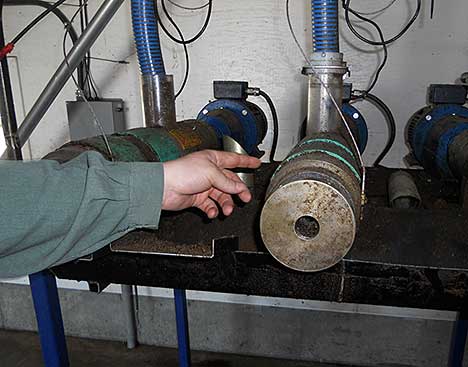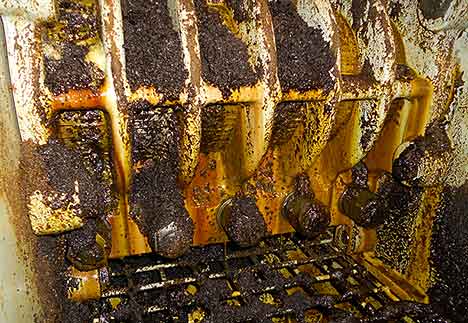| | Cold- or screw-pressed canola cake | Expeller-pressed canola cake | Solvent-extracted (conventional) canola meal | Residual oil is a good deal | Canola meal for finishing hogs and gestating sows | Glucosinolates a concern?
Canola cold-pressed, expeller-pressed or solvent-extracted. What is the difference among these products, and why should it matter to pork producers?
After more than 30 years, pork producers have become familiar with feeding conventional canola meal. But in recent years, new terms have emerged that refer to novel canola co-products for animal feeding. Producers may wonder what these terms mean and what the differences are among co-products.
And for the bottom line, excellent buying opportunities exist when shopping for canola co-products to increase profit margins and reduce feed costs.
Cold- or Screw-pressed Canola Cake
When oilseed is pressed using a screw within a housing barrel, it is referred to as “screw-pressed” (see Figure 1). This term is preferred rather than “cold-pressed.” Screw pressing is “colder” relative to expeller pressing (see the following section), but it still generates some heat by friction.
Cold- or screw-pressed canola is the simplest type of oilseed processing. The process causes strands of churro-like “cake”(churro is a ring-shaped pastry) to shoot out, and oil drips down from the die. Producers with off-grade or immature green seed that crushers will not take can screw-press the seed and feed up to 15 per cent rolled cake to hogs.
The oil can also be fed to nursing sows or weanlings even if stained green. Feeding “green” oil will not hurt the animals, but as the oil is stained with chlorophyll, it would be costly to clear out for human oil consumption.

Figure 1. Simple oilseed screw press to produce cake and oil
for on-farm feed mixing.
Expeller-pressed Canola Cake
Expeller-pressed canola cake has a lower residual oil content (10 to 16 percent) than screw-pressed cake (16 to 22 per cent, see Table 1). A larger screw exerts greater pressure on the seed against a barrel cage lined with bars. The oil drips through the bars, and cake chunks come out at the end of the screw (see Figure 2).
To maximize oil yield, processing plants may “condition” the seed by warming it using a seed dryer before expelling the oil. Or alternatively, they may flake it using steam-heated rollers or “puree” it using an extruder before expelling. Two presses may also be installed in tandem to squeeze oil out of the seed first and then from the cake in sequence.
Producers may feed up to 20 per cent expeller-pressed canola cake in late nursery and grower pig rations. Nursing sows may also benefit from the remaining oil in expeller-pressed cake by including up to 15 per cent expeller cake in the nursing diet, provided that sows have become accustomed to the taste of canola during gestation.
Expeller plants source some heated, off-grade canola seed, so the risk of both contaminants (for example, mycotoxins) and nutrient variability increases. Commodity traders buy the oil from expeller plants and re-sell it either for bio-diesel production or to animal producers as feed-grade oil. Therefore, producers should develop a relationship with cake suppliers, so they can learn to trust the safety and nutrient consistency of the products.

Figure 2. In an expeller press, greater pressure is exerted by a
large screw expelling more oil out of the seed pressed against
a barrel cage lined with bars.
Solvent-extracted (Conventional) Canola Meal
Large crushers that produce oil for human consumption also expel press the canola seed as described before, but the cake is subsequently washed in tanks with a solvent to remove the remaining oil. The solvent is evaporated, and the cake is lightly toasted and ground to make canola meal. Some gums (phospholipids) recovered during oil refinement are added back to the canola meal increasing its fat content somewhat (<3 per cent).
Conventional canola meal is what producers have become familiar with as a supplementary protein source (36 to 38 per cent protein). Canola meal is also the most consistent in terms of nutrient content versus cakes. Meal is also the safest to feed as crushers source mostly #1 or #2 clean canola seed to press for human food oil consumption.
However, canola meal is relatively low in dietary energy value (see Table 1) given that it has no residual oil content. Nonetheless, producers may feed up to 30 per cent canola meal to hogs and gestating sows, and up 20 per cent to nursing sows or weaned pigs in substitution for imported soybean meal.
Residual Oil is a Good Deal
Assuming that a producer is satisfied with the safety and nutrient content of canola cake produced on-farm or sourced from an expeller press plant, Table 1 highlights the economic benefit of the greater residual oil content. Most importantly, residual oil content increases the dietary energy value of canola cake compared with solvent-extracted canola meal.
Cakes do have lower protein due to the greater oil content diluting them. But cakes provide more concentrated calories per bite that increase weight gain and reduce days to market. Late nursery-age pigs and grower pigs benefit the most from feeding canola cake instead of meal. Nursing sows also benefit from the extra calories in canola cake versus meal as the cake helps them reduce body tissue loss, a loss triggered by the need to support milk production for ever larger litters.
Table 1. Comparison of nutrient content and cost per unit of dietary energy
(screw-pressed cake= 20% residual oil, expeller-pressed cake = 10% residual oil and solvent-extracted (conventional) canola meal = 3% fat) |
 | Screw- pressed cake1 | Expeller- pressed cake1 | Solvent- extracted canola meal2 |
| Moisture, % | 12.7 | 9.6 | 10.5 |
| Protein, % | 25.8 | 31.4 | 38.1 |
| Available lysine, % | 1.4 | 1.6 | 2.0 |
| SID lysine, g/kg | 12.0 | 13.2 | 15.0 |
| Fat, % | 20.2 | 10.5 | 2.7 |
| Crude fibre, % | 5.8 | 8.3 | 7.4 |
| NDF, % | 15.3 | 18.8 | 27.4 |
| ADF, % | 11.5 | 15.0 | 19.8 |
| Ash, % | 4.5 | 5.7 | 7.6 |
| P, % | 0.9 | 1.0 | 1.1 |
| Ca, % | 0.5 | 0.4 | 0.6 |
| GE, MJ/kg | 22.3 | 20.9 | 18.1 |
| DE, MJ/kg | 16.5 | 14.3 | 14.0 |
| NE, MJ/kg | 11.5 | 9.0 | 7.7 |
| $/1000 kg | 300 | 300 | 300 |
| ¢/MJ NE | 2.6 | 3.3 | 3.9 |
| ¢/g SID lys | 2.5 | 2.3 | 2.0 |
Grageola, F., J.L. Landero, E. Beltranena, M. Cervantes, A. Araiza, and R.T. Zijlstra. 2013. Energy and amino acid digestibility of expeller-pressed canola meal and cold-pressed canola cake in ileal-cannulated finishing pigs. Anim. Feed Sci. Technol. 186:169-176.
Zhou, X., R. T. Zijlstra, and E. Beltranena. 2014. Nutrient digestibility of solvent-extracted B. napus and B. juncea canola meals and their air-classified fractions fed to ileal-cannulated grower pigs. J. Anim. Sci. Submitted manuscript E-2013-7451.
What is the bottom line for Table 1? Assuming these co-products cost the same ($300/1,000 kg), the cents per megajoule of net energy would be 20 per cent less for screw-pressed cake versus expeller-pressed cake, and 33 per cent less for screw-pressed cake versus solvent-extracted canola meal.
Because dietary energy is the most costly component of feed, producers should choose the co-product with the lowest unit of energy cost, which would also contribute lysine even though it may not provide the lowest cost per gram of standardized ileal digestible (SID) lysine.
Canola Meal for Finishing Hogs and Gestating Sows
Finishing hogs are capable of consuming more feed than young pigs. Gestating sows are limit-fed low calorie diets to prevent excess weight gain during pregnancy. Therefore, neither hogs nor gestating sows would benefit from the extra calories provided by residual oil in canola cake.
Feeding high inclusions of canola cake to finishing hogs may also soften pork fat. Producers must be conscious of this fact as Canada exports a large amount of prime quality pork. Canola meal instead of cake is, therefore, preferred for feeding gestating sows and finishing hogs.
Glucosinolates a Concern?
Glucosinolates in feed are anti-nutritional factors that affect liver and thyroid function. Due to their bitterness, these compounds also reduce the feed intake of pigs. However, glucosinolates have been considerably reduced by genetic selection in modern canola compared with rape or mustard seed.
Conditioning the canola seed before oil expelling and toasting after solvent oil extraction may further reduce anti-nutritional factors. Researchers have repeatedly demonstrated that feeding high inclusions of modern B. napus canola co-products to even young pigs is safe and efficacious.
Conclusions
The time has come to appreciate the economic benefit of feeding different canola co-products. It is also time to change the paradigm that producers feed canola only as a protein supplement.
The residual oil content in canola cake provides protein and a more concentrated source of dietary energy for grower pigs and nursing sows. Conventional canola meal, however, is a better choice instead of cake for feeding finishing hogs that eat more and gestating sows that are limit-fed.
Feeding canola cake instead of meal contributes additional calories per bite that may come at a bargain price even compared with cereal grains. Producers can explore new feeding opportunities when shopping for canola co-products. Keep in mind the risk of greater nutrient variability and feed contaminants, but do not let these factors be a deterrent to reducing feed costs.
Dietary energy is the most costly component of feed representing 85 to 90 per cent of the cost of feed, which in turn represents 66 to 75 per cent of the overall cost of pork production. Therefore, producers should be relentless when shopping for feed energy sources as the cost per unit of feed energy is what has the greatest effect on profit margin over feed cost per hog.
Prepared by
Eduardo Beltranena
Feed Research Scientist
Alberta Agriculture and Rural Development
For more information, contact
Alberta Ag-Info Centre
Call toll free 310-FARM (3276)
Source: Agdex 440/68-2. January 2014. |
|